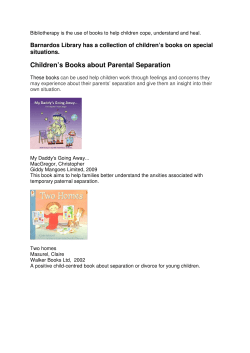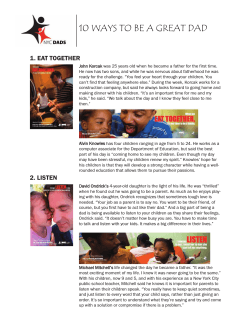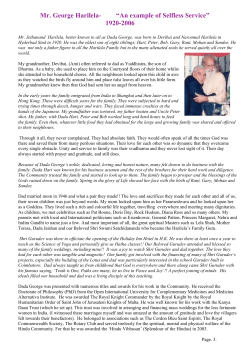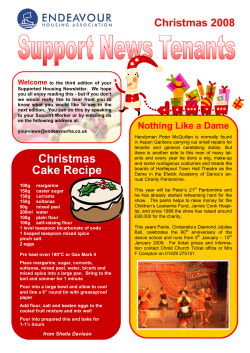
Tahi, Rua, Toru, Whā
T hi, Ru , Toru, Wh Tahi, Rua, Toru, Whā by André Ngāpō by André Ngāpō illustrated by Phillip Paea This text is levelled at Yellow 1. illustrated by Phillip Paea Overview Cross-curriculum links In this story, a dad and his son are getting ready in the morning. The son, who is also the narrator, copies each thing that Dad does. The story finishes with a lighthearted race to the car. Students will enjoy the warmth and humour between the characters, the pattern of the boy repeating Dad’s actions, the race, and the repetition of numbers in Māori. Health and physical education (level 1, relationships) – Explore and share ideas about relationships with other people. Tahi, Rua, Toru, Whā supports the development of a selfextending reading processing system, requiring students to “search for and use interrelated sources of information” and use “a range of word-solving strategies and comprehension strategies to make or confirm meaning” (The Literacy Learning Progressions, page 11). This text also provides opportunities for students to form and text hypotheses and make inferences. There is an audio version of the text as an MP3 file at readytoread.tki.org.nz Health and physical education (level 1, personal health and physical development: personal growth and development) – Describe feelings and ask questions about their health, growth, development, and personal needs and wants. Related texts • Texts that involve family relationships: In the Bush (Red 3); Talking to Nanny (Yellow 1), Walking to School (Yellow 2); Simi Helps, Where is Aunty? (Yellow 3) • Texts about getting ready: Late for the Race (Red 3); Are You Ready, Rosie? (Yellow 1) Text characteristics The students are working towards the standard for after one year at school. Many characteristics of Green texts are also in texts at earlier levels but are in simpler forms. These characteristics are shown in boxes with a solid outline. Other boxes show additional characteristics. The familiar setting and context Illustrations that support and extend the meaning Most content explicitly stated but also some implicit content that provides opportunities for students to make simple inferences and predictions (for example, that the boy will copy his dad) Dialogue between easily identified speakers The inclusion of Māori vocabulary, (“kura”, “Tahi, rua, toru, whā, rima, ono, whitu”) well supported by the context and sentence structure In the morning, Dad got ready for work. Dad put on his shirt. He had a shower He did up his buttons. and brushed his teeth. Tahi, rua, toru, whā. I got ready for kura. I put on my shirt. I had a shower I did up my buttons. and brushed my teeth. Tahi, rua, toru, whā. 2 A range of punctuation, including speech marks, commas, and question marks, to support phrasing, intonation and meaning 3 Sentences that run over more than one line but do not split phrases A macron for the word whā to support pronounication To support word recognition, many high-frequency words, several of which (“Dad”, “had”, “He”, “his”, “my”) are repeated often Interest words (“buttons”, “car”, “faster”, “feet”, “mirror”, “moustache”, “sandals”, “shirt”, “shoes”, “shower”, “teeth”, “winner”, “work”) including regular and irregular verbs (“brushed”, “combed”, “did”, “got”, “had”, “looked”, “moved”, “put”, “race”, “said”, “will”) that are likely to be in the reader’s oral vocabulary and are strongly supported by the context and the illustrations Reading standard: After one year at school The above spread: Text and illustrations copyright © Crown Accessed from www.readytoread.tki.org.nz COPYRIGHT © NEW ZEALAND MINISTRY OF EDUCATION 2014 The Literacy Learning Progressions Teacher support material for Tahi, Rua, Toru, Whā Ready to Read, 2014 1 Suggested reading purpose • Read the title. I wonder what these numbers have to do with getting ready? Pause briefly to see if any students make the connection to the buttons on the shirt, and if not, turn to the title page illustration. Read the title again with the students. I wonder what we can count in this picture. If necessary, direct the students to the buttons on the shirt and count them together (in te reo Māori). • Depending on the students’ proficiency in counting in te reo, you could practise counting up to tekau, referring to a classroom chart so that the students are reminded of the written form of the words. (This will be a useful support for page 7.) • Explain that the boy is telling the story and share the purpose for the reading. • Browse through the book and look at the illustrations together (stopping before the last page) to briefly discuss what is happening. Rephrase the students’ responses or use prompts to draw out (or feed in) new language structures and vocabulary that may need to be supported, for example: (What can the students expect to find out or think about as a result of reading this text?) We are reading this story to find out how the boy and his Dad get ready in the morning. Possible learning goals (What opportunities does this text provide for students to learn more about how to “read, respond to, and think critically” about texts?) The behaviours listed below link to The Literacy Learning Progressions. Select from and adapt them to set your specific learning goal. Be guided by your students’ needs and experiences – their culture, language, and identity. (Reading and Writing Standards for years 1–8, Knowledge of the learner, page 6). This text provides opportunities for students to: • make connections between their own experiences and the information in the story to form hypotheses and make inferences • identify (summarise) the main events • make meaning by drawing on more than one source of information, for example, using sentence structure and context to supplement information gained from partial decoding attempts • notice some errors in their reading and take action to self-correct. • • Use the cover illustration to introduce the topic of getting ready in the morning. Ask the students to share their experiences. What do you do in the morning to get ready for school? Include the word “kura” in the discussion. For English language learners, this book provides a great opportunity for focusing on language within the topic of getting ready. Use mime and pictures to introduce key words and phrases. Together identify the action and read aloud the language, then add the language and the pictures, to a chart or poster. Use the relevant verbs and nouns together to describe the action as a whole phrase, not each item separately (for example, “had a shower”, “brushed his teeth”, “put on his shirt”). on page 2, to support “shower” and “brushed his teeth”, you could ask: What is Dad doing? What else has he done? –– on page 5, to support the boy’s question, you could ask: What is the boy doing? When do you think he will get a real moustache? –– on page 7, to support “moved fast”, ask who they think will move faster and win the race. • After discussing the illustration on page 7, don’t turn the page. Keep the anticipation of the ending for the students to enjoy as they read the story for themselves. • Remind the students of the reading purpose. Introducing the story Use your knowledge of your students to ensure that the introduction to the text activates their prior knowledge and provides appropriate support for a successful first reading. As part of the discussion before reading, draw out (or feed in) new vocabulary and language structures that they may need support with. –– Monitoring the reading • Observe closely as the students read the text to themselves, intervening only if a student clearly needs help. (Some possible prompts are provided below.) • Note their ability to use print information, in particular, initial letters and punctuation, and to read the high-frequency words and groups of words together in phrases. Look for any instances of selfmonitoring, cross-checking, and self-correction. • Enjoy the students’ reaction to the ending and Dad’s question on the last page. • As students finish reading, they can quietly reread the story until everyone has finished. Sounds and words The Literacy Learning Progressions Accessed from www.readytoread.tki.org.nz COPYRIGHT © NEW ZEALAND MINISTRY OF EDUCATION 2014 Teacher support material for Tahi, Rua, Toru, Whā Ready to Read, 2014 2 • If a student makes an error without noticing, wait until the end of the sentence or the page before intervening, unless they stop reading. Waiting gives them the opportunity to notice the error and fix it. • • Some prompts that you could use include: Did that look/sound right to you?; Are you sure?; Were you right?; Try that again ... and think about what would make sense.; Think about what would sound right and look right.; Look at the beginning of the word.; Read the sentence again. Discussing the text • • • Remember to base your prompts on what you know about the students’ prior knowledge. For example, asking an English language learner if a word sounds right may not be useful if they are not familiar enough with English phonemes and vocabulary to know the answer. In this case, an explanation and further examples would be more effective. Reinforce students’ attempts to problem-solve, whether they are successful or not, for example: You noticed something was wrong, and you went back to try again. That was good. Or: You are checking on your reading and fixing it ... great. Other prompts could include: Text in book Student reads Teacher prompt I got ready for kura. I got ready for school ... I got ready for k_____. What did you notice? Do you know the Māori word for school? Go back and try that again. Tell the student the word if they don’t know. Reinforce the monitoring attempt. You noticed that the word wasn’t “school” and tried to work out “kura”. That was good work. I combed my hair, just like Dad. I combed my hair, like Dad did. When you read this sentence, you said “I combed my hair, like ...” Check if that looks right. I said, “Dad, when will I have a moustache?” I said, “Dad we ... (reruns and stops) Prompt the student Accessed from www.readytoread.tki.org.nz COPYRIGHT © NEW ZEALAND MINISTRY OF EDUCATION 2011 to use meaning. He’s asking Dad a question here. What is he asking Dad about? For further suggestions about ways to support students to self-monitor (to cross-check, confirm, and self-correct), see Effective Literacy Practice in Years 1 to 4, page 130. • When they have finished reading, remind the students of the reading purpose and identify what the boy and his dad did to get ready (summarise). • Discuss why the students think the story was called Tahi, Rua, Toru, Whā. If necessary, go back and review page 3. • Prompt them to think critically. What have you learned about Dad and the boy? Expect them to talk about the boy repeating what Dad is doing and the fun they had. Extend their thinking about the story by linking to their own experiences. Do you think they play that game every morning? Do you have competitions like this with your family? After reading: practice and reinforcement After-reading tasks should arise from your monitoring of the students’ needs during the lesson and should provide purposeful practice and reinforcement. Where possible, make links to other reading texts, including texts generated from language experience and shared writing, texts from the wider literacy programme (oral language, writing, handwriting, alphabet and word games and activities), and texts from other curriculum areas. Select from and adapt these suggestions, according to the needs of your students. • Have the students reread the text aloud to a partner. Listen in, providing feedback to individual students, and noting their ability to self-monitor and to use the punctuation to support phrasing and expression. You may also use this time to do a quick running record with a student to provide more information on something you have noticed. • Provide many opportunities for the students to reread this text and to read other stories and poems with similar themes (see Related texts). This also helps to extend their comprehension. • They can also build their comprehension and fluency by rereading the text while listening to the audio version. Audio versions also provide English language learners with good models of pronunciation, intonation, and expression. Teacher support material for Tahi, Rua, Toru, Whā Ready to Read, 2014 3 • For English language learners, provide further support for the language about getting ready. Give the students copies of the phrases for the actions in the story. Have them listen to the audio, pausing after each page or two, and point out the phrases in the order that they hear them. They can place the cards in the correct order. Have the students listen again and check. Play a game or plan an activity with the students where they count items or actions in te reo Māori, such as going to the playground and counting as they play on the equipment. Have them paint or draw what they did and write a caption to match, for example, “I climbed up the steps. Tahi, rua, toru, whā!” or “I saw some ducks. Tahi, rua, toru.” Display their work so they can share and reread with each other and with visitors to the classroom. • Give the students the words and phrases to describe actions for getting ready, with the nouns and verbs on separate cards, for example, “had”, “put on”, “brushed”, “combed”, “his/my shoes”, “a shower”, and so on. Have the students match the verbs and nouns. Support them to say and then write what they did to get ready this morning. If necessary, provide sentence starters, “This morning, I _______”, or give them sentences using their own words and have them fill in the blanks. "This morning I ______ a shower. Then I brushed my ___________”. Note that to keep the same structure as the text, you will need to ask them to talk about what they did this morning (in the past), not what they do in the morning (always). • Have the students reread the story to a buddy. Remind them to make it sound interesting. This could be followed up by revisiting page 7 and counting in te reo Māori together to tekau, or as far as they can. They could refer to a classroom chart to help them. • Revisit the story and discuss the fun Dad and the boy had as they got ready. Get them to talk about the competitions they have won at home, for example: racing to ..., being first to ... You could work together on a group book about “Fun we have at home”. The students could take turns to share this with their family. • Revisit the last page and have the students think of other questions and answers the boy and Dad might have when they’re in the car on the way to school. Ask them to use the words “When” and “One day” to construct the boy’s questions and Dad’s answers. • Ask the students to open to a particular page and locate words with particular initial letters, blends, or digraphs. For example on page 2: What word on this page starts the same as “bridge” and “brother”? Read the sentence you found it in. What is the word? Do you know another word that starts like that? • Have the students look closely at words from the story and focus on how endings make new words, for example, reread page 7 and focus on “fast” and “faster”. They could write and display their own sentences for “fast” and “faster”, using a similar frame: ______ ______ fast. But I ______ ______. (For example, Ben swam fast. But I swam faster!) Tahi, Rua, Toru, Whā Accessed from www.readytoread.tki.org.nz COPYRIGHT © NEW ZEALAND MINISTRY OF EDUCATION 2014 Teacher support material for Tahi, Rua, Toru, Whā Ready to Read, 2014 ISBN 978 0 478 44603 6 (ONLINE) 4
© Copyright 2025











